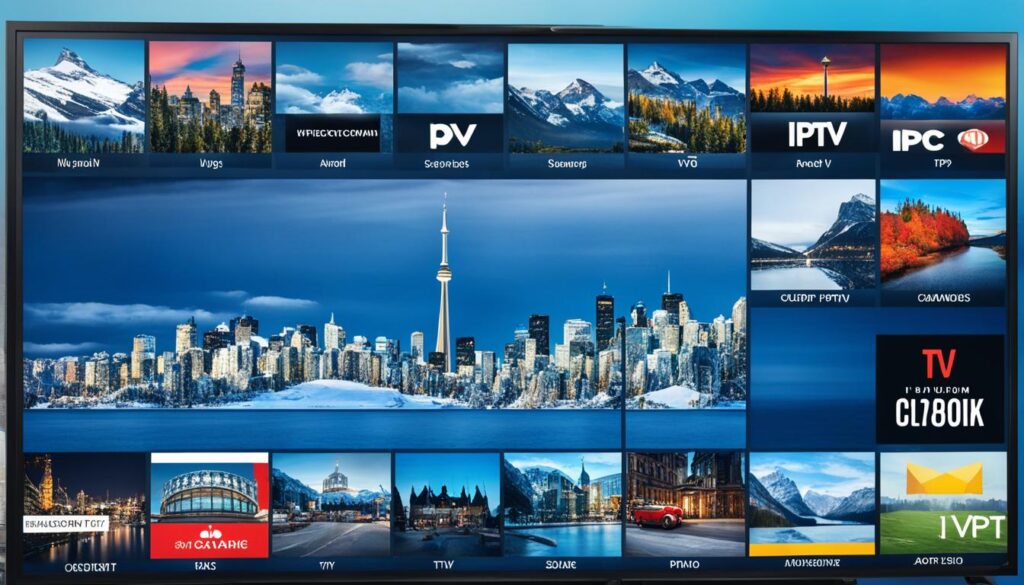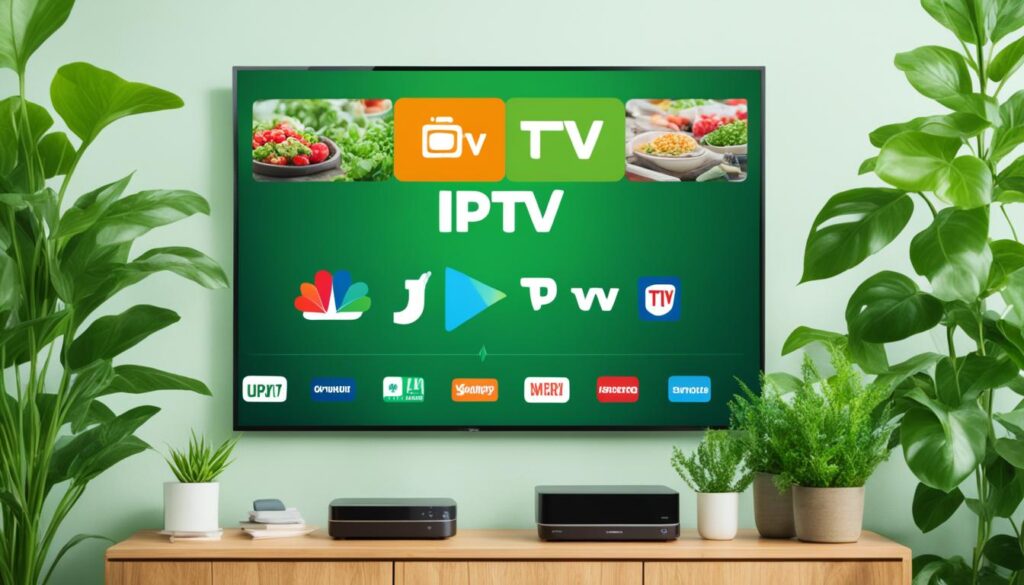Have you ever wished for a TV viewing experience entirely tailored to your preferences, with the freedom to watch what you want, when you want? Welcome to the world of IPTV Canada, where on-demand streaming and flexible viewing are transforming how Canadians enjoy entertainment.
In an era where high-quality internet access spans from eastern cities to the western frontiers, IPTV services are capitalizing on this connectivity to provide a diverse range of options for viewers1. Offering a massive selection of over 98,000 channels in high-quality formats, IPTV services are revolutionizing traditional TV watching habits in Canada1. This technological advancement allows you to personalize your channel lineup to include global content, reflecting Canada’s rich multicultural tapestry1.
Whether you’re drawn to over 150,000 series and films on Video on Demand1, or the impressive collection of 17,000 on-demand movies and 3,500 TV series2, IPTV caters to your unique viewing needs. Furthermore, the competitive pricing and special time-limited offers make it easier for new and returning subscribers to enjoy these enhanced services2. From seamless connectivity for multiple devices within a household to customer-centric features like multiple connections and channel requests, the benefits of IPTV are genuinely expansive2.
Key Takeaways
- IPTV Canada offers over 98,000 high-quality channels for diverse viewing preferences1.
- Access an extensive library of 150,000 series and films on Video on Demand1.
- Enjoy over 12,000 live TV channels with seamless multi-device connectivity2.
- Leverage competitive and flexible pricing plans for cost savings2.
- Personalize your viewing experience with global content and exceptional customer service13.
Introduction to IPTV in Canada
In Canada, IPTV technology has been gaining substantial traction due to several key factors, making it an increasingly preferred choice for multimedia content consumption over traditional cable services. With the widespread availability of high-speed internet and advanced streaming technology, IPTV allows users to access live sports, news, movies, and international content from a variety of devices such as smartphones, tablets, and smart TVs4.
Definition and Basics of IPTV
IPTV, or Internet Protocol Television, is a system where television services are delivered using the internet rather than through traditional cable or satellite formats. This technology leverages IP networks to stream multimedia content directly to users, providing more flexibility and interactive features compared to conventional broadcasting methods. Major telecommunications providers like Bell, Rogers, Telus, and Shaw are at the forefront of offering IPTV services in Canada5. Additionally, independent internet providers such as Teksavvy and Distributel also provide legal IPTV services5.
Growth and Popularity in Canada
The growth of IPTV in Canada is driven by changing consumer preferences, advancements in streaming technology, and the availability of high-speed internet4. IPTV services often prove to be more cost-effective than traditional cable, with competitive pricing and customizable packages that allow users to pay only for the channels they want4. Some providers can offer services starting as low as $20 per month, making IPTV an attractive option for many Canadians5. Moreover, the ability to watch content anytime, anywhere, on multiple devices significantly enhances the convenience for users4.
Several major Canadian IPTV providers have contributed to this rise by offering diverse channel options and ensuring high-quality streaming through robust internet speeds5. The flexibility and variety offered by IPTV services continue to make it a popular choice among Canadian consumers, further bolstered by legal and occasionally free options such as VMedia and Pluto TV6.
What is IPTV?
Internet Protocol Television (IPTV) is revolutionizing the way we consume media by offering personalized entertainment through the delivery of television/video/audio/text/graphics/data via IP networks, ensuring quality of service, security, interactivity, and reliability7. Unlike traditional cable, IPTV services may include live television, live media with interactivity, video on demand (VOD), and catch-up TV, offering unparalleled flexibility and convenience for viewers7.
How IPTV Differs From Traditional Cable
IPTV differs significantly from traditional cable TV in its method of content delivery. While cable TV relies on analog or digital signals transmitted through coaxial cables, IPTV transmits encoded TV signals as IP packets over the internet7. This method allows for streaming media players to deliver content seamlessly, with options for on-demand and time-shifted viewing, representing a major shift from the fixed schedules of cable TV.
Technological Advancements Making IPTV Possible
The technological advancements that have propelled IPTV into mainstream use include enhanced data compression techniques and high-speed data transmission capabilities. The integration of these technologies ensures that streaming high-definition (HD) and even ultra-high-definition (UHD) content is not only possible but also reliable8. Hybrid IPTV, which combines traditional TV services with IP-based ones, has also enabled providers to expand offerings without a complete overhaul, fostering more widespread adoption9.
The International Telecommunication Union’s definition of IPTV highlights its capacity to provide multimedia services with an emphasis on quality and interactivity7. As a result, the rapid growth of IPTV is evident, with its market value set to double by 2029, underlining the industry’s substantial growth potential9.
- Live IPTV services, like FOX Sports Go and Hulu Live TV, offer real-time streaming of content over the internet, reflecting the growing demand for live sports broadcasting on IPTV platforms9.
- Major VOD services such as Netflix, Hulu, and Amazon Prime Video demonstrate the strong market presence of IPTV, with users enjoying the flexibility to watch content anytime and anywhere on various devices including smart TVs, computers, and smartphones98.
The Benefits of IPTV Over Traditional Cable
IPTV is revolutionizing the Canadian media consumption landscape by offering numerous benefits over traditional cable. This section delves into the key advantages.
Cost-Effectiveness
One of the significant benefits of IPTV is its cost-effectiveness. Many IPTV services provide competitive pricing models that are more affordable than traditional cable or satellite TV subscriptions, making IPTV a cost-effective alternative10. Users can often select customizable packages, allowing them to pay only for the content they choose rather than mandatory bundled services.
Flexibility and Convenience
The flexibility offered by IPTV is unrivaled. It enables content streaming on various devices including smart TVs, smartphones, tablets, and computers, enhancing user experience and accessibility11. Users can access an extensive library of on-demand content, providing the flexibility to watch what they want, when they want11. Additionally, IPTV platforms often offer interactive features such as pause, rewind, and fast forward, enhancing user control over content consumption11. This flexibility extends to convenience, as viewers can enjoy their favorite shows anytime, anywhere, promoting a seamless streaming service experience across multiple devices10.

Wide Range of Channels
IPTV offers access to thousands of channels from around the globe, providing viewers with a vast array of content options spanning genres, languages, and cultures10. This includes live sports, international programming, and niche channels tailored to specific interests, which may not be readily available on traditional cable television11. Enhanced parental controls on IPTV platforms empower parents to monitor and regulate their children’s viewing habits, contributing to a family-friendly viewing environment10. Furthermore, many IPTV providers offer cloud DVR services, allowing users to record, store, and access content from any device, enhancing flexibility11.
IPTV on-demand content: The Ultimate Streaming Experience
With the evolution of technology, Canadian viewers now enjoy an unprecedented level of choice and convenience through IPTV services. Offering extensive libraries of video on demand options, viewers can indulge in their favorite shows and movies at their own pace, thereby redefining the notion of binge-watching. For instance, Freedom Stream IPTV boasts over 8,800 live TV channels, including an extensive array of international and premium sports packages to cater to diverse preferences on their IPTV content selection12. Furthermore, their service promises a seamless streaming experience in high-definition and 4K quality, eliminating common frustrations like buffering and lags12.
One of the greatest benefits of IPTV is the affordability and flexibility it offers. Unlike traditional cable subscriptions, IPTV services are tailored to fit various budgets and viewing needs1213. For example, Xtreme HD IPTV provides over 20,000 live channels and 40,000 VOD options, while IPTV Trends offers over 10,000 live channels and a vast library of on-demand content13. This variety ensures that viewers across Canada have access to customized entertainment options.
Embracing IPTV content selection allows users to navigate easily between live programming and on-demand content. This flexibility enables them to never miss out on their favorite shows while also exploring new genres and international content12. Moreover, algorithms within IPTV platforms suggest personalized content based on viewers’ history and preferences, enhancing the overall viewing experience14.
As IPTV technology continues to evolve, content providers are likely to further enrich their libraries, offering even more diverse genres and catering to a broader range of audiences. The shift towards IPTV is evident in the increasing popularity of binge-watching, where users have the freedom to watch multiple episodes in one go, adapting their viewing habits to their schedules14.
The future looks bright for IPTV, with advancements such as 5G networks promising to improve streaming quality, and AI-driven personalization offering tailored recommendations that fit the unique taste of every viewer14. Overall, IPTV on-demand content is transforming the way Canadians consume entertainment, making it truly the ultimate streaming experience.
| IPTV Provider | Live Channels | VOD Library |
|---|---|---|
| Freedom Stream | 8,800+ | Extensive |
| Xtreme HD IPTV | 20,000+ | 40,000+ |
| IPTV Trends | 10,000+ | Vast |
| RocketStreams | 3,000+ | Extensive |
| Beast IPTV | 12,000+ | Significant |
How IPTV Works?
IPTV technology enables viewers to access multimedia streaming by transmitting TV programming and video content using IP networks. This functionality contrasts with traditional television delivery methods and highlights the unique processing steps that make IPTV possible.
Transmission via Internet Protocol
The core of IPTV’s operation lies in its use of Internet Protocol to transfer data packets across the internet. This method ensures that media content is encapsulated into IP packets, which are sent seamlessly over IP networks to compatible devices15. Unlike traditional cable or satellite TV that relies on wired or wireless connections, IPTV leverages the robust and scalable architecture of IP-based networks16. The delivery method of IPTV varies and can include IP multicast streams, VOD platforms, and live TV streaming servers16. Additionally, IPTV services from providers such as Netflix and Apple often run on dedicated or managed networks to maintain high video traffic quality15.
Encoding and Decoding IP Packets
Once the media content is transmitted over the IP network, the next critical step is decoding these packets for viewing. An IPTV-compatible device, typically through an IPTV set-top box (STB), is responsible for decoding and decrypting TV and video on-demand streams16. This allows viewers to enjoy clear and high-quality content, exemplified by higher resolutions such as 4K and HDR17. The versatility of these devices also means content can be accessed across various platforms, offering an unparalleled multimedia streaming experience on smartphones, tablets, and smart TVs. IPTV’s flexibility and convenience allow multiple TV sets in a household to use a single subscription, giving viewers the advantage to watch what they want, when they want16.
The seamless operation of IPTV illustrates its essential role in modern digital entertainment, meeting the increasing demand for diverse and high-quality content across different user profiles, including sports enthusiasts, movie fans, and tech-savvy individuals17.
Types of IPTV Services in Canada
In Canada, IPTV services cater to diverse viewer preferences through two primary types: Managed IPTV services and Over-the-Top (OTT) IPTV services. These offerings vary significantly in terms of delivery methods, features, and flexibility, providing consumers with a variety of choices to suit their individual viewing habits.
Managed IPTV Services
Managed IPTV services are typically provided by telecom carriers and often bundle with internet and phone services. These services ensure reliable quality and come with the convenience of single-provider billing. Telus is a prominent telecom IPTV provider in Canada, offering plans starting at approximately $75 per month, including On Demand and Pay Per View services18. Shaw Direct also offers robust IPTV solutions with packages starting at around $60 per month, featuring both HD and 4K content18. Customers can enjoy a seamless viewing experience with comprehensive support and service guarantees.
Over-the-Top (OTT) IPTV Services
OTT IPTV services deliver content solely over the internet and are independent of Internet Service Providers (ISPs). This type is highly appealing to consumers who seek flexible, specialized content without the necessity of additional telecom services. Providers such as DigitaLizard IPTV offer access to over 20,000 live TV channels and 80,000 VOD titles, with pricing starting at $8 per month19. PrimeSALTO, another OTT provider, boasts more than 22,000 live channels and 130,000 VOD options, with flexible pricing plans starting as low as $11.99 per month19. With such a wide array of choices, consumers are sure to find services that match their specific content preferences and budget.

Moreover, OTT IPTV services like IPTVAnubis offer access to 27,000+ channels and 130,000+ series and movies, appealing to Canadian viewers seeking extensive content libraries19. These standalone streaming options provide a cost-effective alternative to traditional cable, allowing users to watch their favorite shows on multiple devices with ease20.
Overall, whether you opt for managed IPTV services from Canadian content providers such as Telus and Shaw Direct, or standalone streaming through OTT services like DigitaLizard IPTV and PrimeSALTO, there are abundant choices available to elevate your television viewing experience.
Choosing the Right IPTV Service in Canada
When selecting the right IPTV service in Canada, it is essential to consider several factors including content variety, pricing, plan flexibility, reliability, and customer support. With a growing interest in IPTV services as an alternative to traditional cable and satellite TV, the market offers numerous providers to choose from21.
Comparing Available Options
Subscribers are encouraged to undertake an IPTV comparison of various providers. Examining the content variety is crucial; IPTV services often provide a broader range of content, including live TV, on-demand movies, TV shows, and exclusive channels21. It’s also beneficial to look for providers like Canacast and Icing IPTV, which are known for their extensive channel lineups and high-quality streaming options22.
Evaluating Pricing and Features
Evaluating the pricing and features of different subscription plans is another significant step. Cost-effectiveness is a considerable advantage of IPTV, with many providers offering more affordable options compared to traditional cable services21. Key features such as cloud DVR functionality, catch-up TV, and multi-screen support can greatly enhance customer satisfaction21. Additionally, devices compatibility and customer support availability are essential for a seamless viewing experience23.
Setting Up IPTV in Your Home
The growing trend of IPTV in Canada has brought an extensive range of on-demand channels and content to users’ fingertips24. For a seamless IPTV experience, it’s crucial to have the right setup. This includes both the necessary equipment and a streamlined installation process.
Required Equipment
Canadian households need the right IPTV equipment to enjoy optimal streaming. Essential items include:
- A high-speed router
- A smart TV or streaming media player (e.g., Roku, Firestick, Android boxes)
- HDMI or Ethernet cables
- An IPTV subscription
A robust internet connection is fundamental for uninterrupted service, with stability and bandwidth playing critical roles24
Installation Process
Installing IPTV involves a few straightforward steps, ensuring users can quickly transition from traditional cable to IPTV. Here’s a general outline:
- Connect your device to the high-speed router using either Wi-Fi or Ethernet cables.
- Download the IPTV app recommended by your service provider (e.g., IPTV Smarters, Room IPTV) onto your smart TV or streaming device25.
- Register for an IPTV service, which should be streamlined without any hassle for a seamless activation24.
- Log in to your user account and begin customizing your viewing experience with the IPTV installation26.
For more detailed guidance, refer to providers like [GetMaxTV](https://getmaxtv.com/.).
Optimizing Your IPTV Experience
To maximize your IPTV experience, it’s crucial to start with a stable internet connection. For HD streaming, a minimum speed of 25 Mbps is recommended, while 4K content demands at least 50 Mbps27. The number one reason for buffering and freezing in IPTV is inadequate internet speed, which should be at least 25 Mbps when connecting directly to the modem28. To enhance streaming quality wirelessly, consider using Power-over Ethernet adapters with 1000 Mbps or Wi-Fi adapters with 300 Mbps28.
Internet Speed Requirements
Having the right internet speed is integral not only for running IPTV but also for minimizing buffering issues. Check if your router supports the necessary speeds, with models like D-Link recommended for their reliability in transmitting streaming content28. If persistent connectivity problems occur, perform internet speed tests and consider repositioning your devices closer to the router28. For an even more stable connection, Ethernet Power Line Adapters, costing between $70 – $100, can provide a consistent performance by bypassing Wi-Fi28.
Adjusting App Settings for Better Performance
Optimizing your IPTV experience extends beyond internet speed; it also involves app customization. Ensure your apps are regularly updated to benefit from improved streaming quality and new features27. Additionally, periodically clearing the cache can boost performance and reduce the likelihood of app crashes27. Adjust video resolution and audio preferences within the app settings to match your desired playback quality and available bandwidth, which can reduce interruptions and enhance overall viewing pleasure. By following these strategies, you can ensure a smoother and more enjoyable IPTV experience.
FAQ
What is IPTV?
IPTV, or Internet Protocol Television, delivers television content through IP networks such as the internet, diverging from traditional cable’s dedicated infrastructure. It offers a more customizable and on-demand viewing experience with a broader range of channels and simplified access via multiple devices.
How does IPTV differ from traditional cable?
Unlike traditional cable, IPTV transmits encoded TV signals as IP packets over the internet, allowing for more personalized and flexible entertainment experiences. This setup enables users to watch content on various devices and provides a greater selection of programs.
What technological advancements have made IPTV possible?
Advancements such as improved data compression and high-speed data transmission have made IPTV accessible and reliable for streaming live TV and on-demand content. These technologies ensure smoother streaming and higher-quality video.
Why is IPTV becoming popular in Canada?
IPTV’s growth in Canada is fueled by widespread high-speed internet access, changing consumer behaviors, and technological improvements. Canadians are drawn to IPTV’s vast and diverse channel offerings, personalized viewing options, and cost savings compared to traditional cable services.
What are the cost-effectiveness benefits of IPTV over traditional cable?
IPTV is often more cost-effective due to competitive pricing and the absence of mandatory bundled services. This allows viewers to pay for only the content they choose, avoiding unnecessary costs associated with traditional cable packages.
What flexibility and convenience does IPTV offer?
IPTV allows users to watch content on various devices, such as smartphones, tablets, and smart TVs, providing the convenience of accessing programs anywhere at any time. Its on-demand nature also means viewers can watch what they want when they want.
What is ‘IPTV on-demand content’?
IPTV on-demand content provides viewers with a multitude of choices, from TV series to movies, which they can access according to their schedule. This greatly enhances the viewing experience by allowing for binge-watching and seamless navigation between live and on-demand programming.
How does IPTV work?
IPTV functions by converting media content into IP packets, which are sent over internet protocol networks to the viewer’s IPTV-compatible device. This device decodes the packets, presenting the content seamlessly on-screen. The technology supports streaming across various platforms.
What types of IPTV services are available in Canada?
In Canada, IPTV services are bifurcated into managed IPTV, typically offered by telecom carriers along with bundled services, and Over-the-Top (OTT) IPTV services, which deliver content solely over the internet independently of ISPs, often providing specialized and international content.
How can I choose the right IPTV service in Canada?
When selecting an IPTV service, consider factors such as content variety, pricing, plan flexibility, reliability, and customer support. Compare offerings from different providers to identify the one that best aligns with your preferences and provides the optimal user experience, pricing, and content diversity.
What equipment is required to set up IPTV in my home?
To use IPTV, you need compatible equipment like a smart TV or streaming media player, and a robust internet connection. Most IPTV service providers offer step-by-step guidance for installation, making the transition from traditional TV services to IPTV straightforward.
What internet speed is required for optimal IPTV performance?
A stable and high-speed internet connection is essential for an optimized IPTV experience. A minimum internet speed of 10 Mbps is recommended for HD streaming. Users can also adjust app settings like video resolution and audio preferences to enhance streaming quality and minimize buffering.



